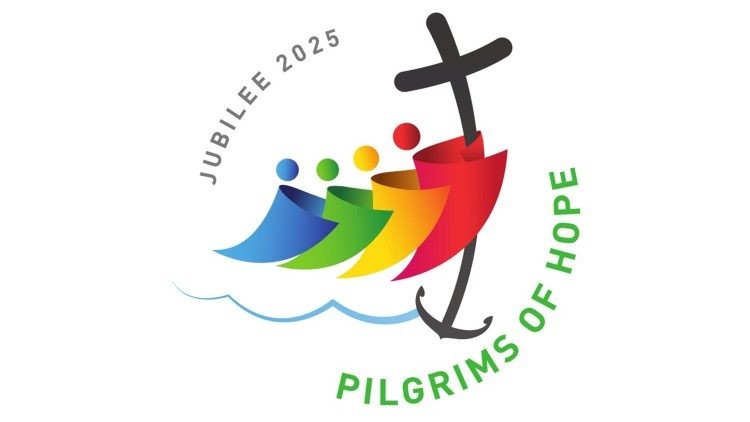Author: Gerald M. Kimario, AJ
Introduction
The Jubilee, a holy tradition observed every 25 years, is a profound opportunity for spiritual rebirth, reconciliation, and hope. Pope Francis inaugurated the Jubilee Year 2025 on Christmas Eve 2024, opening the Holy Door of St. Peter’s Basilica in Rome—a symbolic gesture echoed by bishops worldwide on the Feast of the Holy Family (29th December 2024). This global act marks the Jubilee as a transformative moment for the Universal Church, inviting the faithful to embark on a pilgrimage of faith and mercy.
The Essence of Pilgrimage
Etymologically, pilgrimage or peregrinum comes from two Latin words per and ager; per means through, and ager means field or land. Thus, peregrinum means foreigner or wanderer. In our context, the concept indicates a journey across a distance. The nature of such a journey is visiting foreign lands with a purpose. In most cases, associated with spiritual transformation or religious devotion.
It is precisely in this context that pilgrimage is more than a physical journey. It is a metaphor for the soul’s quest for meaning. It embodies the human longing for divine encounter. It is a deliberate movement towards God and shedding off worldly attachments that hamper spiritual growth. In the Jubilee context, pilgrimage becomes a path to conversion, urging believers to leave behind what is not pleasing to God and embrace spiritual renewal.
The Concept of Jubilee
The term “Jubilee” is from the Hebrew word yobel, implying “ram’s horn”. This horn was used among the Hebrew community to announce celebrations. The concept is also reflected among the Greek people as iobelaios or iobelos. Currently, it is associated with the Latin term jubilo, meaning “to shout.”
Jubilees, in the life of the Church, are extraordinary moments of renewal and grace. There are times of “explosion” of our faith, moments to celebrate, return to the sacraments, and experience conversion of heart. Thus, the Jubilee Year is a special time set aside for profound spiritual renewal, reflection, reconciliation, restoration, and celebration of the faith.
Types of Jubilees in the Catholic Church
There are two main types of Jubilees in the Catholic Church, viz, Ordinary Jubilees and Extraordinary Jubilees. The Ordinary Jubilees occur at regular intervals, traditionally every 25 years, and are celebrated to mark specific periods of reflection, renewal, and forgiveness within the Church. This year we are celebrating an Ordinary Jubilee year.
The Extraordinary Jubilees describes offering the faithful special opportunities for spiritual renewal and indulgences outside the regular 25-year Jubilee cycle. Why an extraordinary Jubilee? Commemorate special events in the Church’s history, times of great difficulty or calamity, to encourage the faithful and offer spiritual graces; to grant specific indulgences, which are more demanding than those of an ordinary plenary indulgence. The 2016 Jubilee of Mercy was an extraordinary jubilee, and it started on 8th December 2015 and ended on 20th November 2016, the Feast of Christ the King.
The Jubilee 2025 Logo: A Visual Testament of Hope

The logo’s design is rich with symbolism. The Four Colours (Blue, Green, Yellow, Red) represent humanity’s diversity converging in unity, while the embracing colour figures signify global solidarity and fraternity. The figure in front embraces the cross, signifying our need to embrace the faith and hold on to the cross. The Cross is a symbol of our faith and hope in Christ, which must never be abandoned. The blue waves signify the rough times humanity continues to go through. The cross is not straight, but bent over, almost stooping down toward humanity, symbolizing Christ’s hope amid life’s storms. Finally, the Motto: “Pilgrims of Hope” is a call to steadfast trust in God’s promises, with green letters symbolizing growth and renewal as part of our communal pilgrimage.
Biblical Meaning of Holy Door
Biblically, the concept of doors is deeply symbolic. The opening of the Porta Sancta recalls key moments in Scripture, such as the expulsion of Adam and Eve from the Garden of Eden (Gn 3:23-24), and the closing of the door of Noah’s Ark (Gn 7:16). Other instances referring to the concept of doors include the parable of the ten virgins and the closed door (Mt 25:1-13), the “Narrow Door” (Lk 13:24), and Acts of the Apostles, where apostle Paul speaks of how God “opened a door of faith to the Gentiles” (Acts 14:27).
Jesus announced the fulfilment of the Jubilee. This means a time of grace, freedom, and renewal. “For everyone, may the Jubilee be a moment of genuine, personal encounter with the Lord Jesus, the door (Jn 10:7-9) of our salvation, whom the Church is charged to proclaim always, everywhere, and to all as ‘our hope’ (1 Tm 1:1).
Understanding the Holy Door
The opening and closing of the Porta Sancta (Holy Door) is one of the most significant and symbolic rituals of the Jubilee Year in the Catholic Church. It involves opening the Holy Doors of the four major basilicas in Rome—St. Peter’s, St. John Lateran, St. Paul Outside the Walls, and St. Mary Major—to offer special graces and invite the faithful to repentance and spiritual renewal.
The Porta Sancta represents a passage from sin to grace, an invitation to enter into God’s mercy.
At the close of the Jubilee, the Porta Sancta is sealed again, marking the end of this special period of grace and spiritual transformation.
The Concept of “Hope”
Hope means to have confidence and trust that something one desires will happen. The CCC points out that “Hope is the confident expectation of divine blessing and the beatific vision of God; it is also the fear of offending God’s love and of incurring punishment” (CCC 2090). Hope is one of the divine virtues. Other divine virtues are faith and charity.
Understanding the concept of hope assists in opening up to grand ideals that make life more beautiful and worthwhile. Hope is bold, and it enables us to look beyond personal convenience, superficial securities, and the small compensations that narrow our horizons.
The Bull of Indiction of the Jubilee Year
On 9th May 2024, the Solemnity of the Ascension of our Lord Jesus Christ, Pope Francis officially announced the Ordinary Jubilee of the Year 2025 through the Bull of Indiction Spes non Confundit.[1] As expected, the Bull indicates the dates of the beginning and end of the Holy Year. More importantly, it provides the details and offers guidelines to the faithful throughout the celebration of how the Jubilee year should be conducted. In this sense, the Papal Bull outlines the spiritual significance of the Jubilee, the key themes such as hope and mercy, and the conditions for obtaining indulgences.
Spes non confundit is centred on the theme of hope.[2] From the Bull we learn that “Hope does not disappoint” (Rom 5:5). Christian hope does not deceive or disappoint because it is grounded in the certainty that nothing and no one may ever separate us from God’s love. Such love of God, Saint Paul expresses further, that has been poured into our hearts through the Holy Spirit that has been given to us (Rom 5:5). For Pope Francis, the nature of such message of hope contains three dimensions which include fulfilling the ancient promises, leading to glory, and grounded in love. Thus, hope does not disappoint.
Everyone knows what it is, to hope. In the heart of each person, hope dwells as the desire and expectation of good things to come, despite our not knowing what the future may bring. Hope is born of love and based on the love springing from the pierced heart of Jesus upon the cross.
What is an Indulgence?
An indulgence is the remission before God of the temporal punishment due for sins whose guilt has already been forgiven. It is granted by the Church, which, as the minister of redemption, dispenses and applies with authority the treasury of the satisfactions of Christ and the saints (CCC 1471-1472).
Reasons for an Indulgence after Confession and Absolution
In the Sacrament of Baptism, both the guilt of sin and all the penalties attached to it are completely removed. However, in the Sacrament of Penance (Confession), while the guilt of sin is forgiven and the eternal punishment due to mortal sin is taken away, there remains a temporal punishment that must be satisfied.
This temporal punishment is required by Divine Justice and must be fulfilled either in this life or in the next, specifically in Purgatory. In fact, in our humanity, weak and attracted by evil, certain residual effects of sin remain.[3] These are removed by the indulgence, always by the grace of Christ.
An indulgence provides a way for the penitent sinner to discharge this temporal debt while still on earth, through the Church’s application of the merits of Christ and the saints. In this way, indulgences allow the faithful to mitigate or even fully remove the temporal consequences of sin during their lifetime, reducing or eliminating the need for purification in Purgatory.
Types of Indulgences
Indulgences are classified as either partial or plenary. A partial indulgence removes part of this punishment, while a plenary indulgence removes all of it. These indulgences can be applied either to the living or to the souls of the deceased, offering them relief from the temporal consequences of their sins.
Jubilee Indulgence
This is a plenary indulgence granted in the most generous form possible. Conditions for obtaining a Jubilee Indulgence: Confession, Communion, visits to the four major basilicas in Rome, and any other significant places of worship as per the guidelines from the Bull during a specified period.
Ways to gain an indulgence during the Jubilee of 2025
These include Pilgrimages, Pious Visits to Sacred Places, and Works of Mercy. Works of mercy and charity are signs of hope. Rediscovering the corporal works of mercy: feed the hungry, give drink to the thirsty, clothe the naked, welcome the stranger, heal the sick, visit the imprisoned, and bury the dead, are signs of hope.
Other Ways to Obtain the Jubilee Indulgence
- Participation in Spiritual Activities
- Acts of charity for the souls in purgatory
- Works of mercy and charity
- Making a pilgrimage to those in need (Mt 25:34-36)
- Penitential practices, e.g., abstaining from futile distractions, fasting or practicing abstinence, and donating to the poor or supporting charitable causes.
Necessary conditions in all cases for plenary indulgences
To obtain any of the plenary indulgences listed above, the following conditions must be fulfilled:
- Detachment from all sin, even venial
- Sacramental confession
- Receiving of Holy Communion
- Prayer for the intentions of the Pope
These four conditions can be fulfilled a few days before or after performing the works to gain the indulgence, but it is appropriate that Communion and the Prayer take place on the same day that the work is completed.
A single sacramental confession is sufficient for several plenary indulgences, but frequent sacramental confession is encouraged to obtain the grace of deeper conversion and purity of heart. For each plenary indulgence that is sought, however, a separate Holy Communion and a separate Prayer for the intentions of the Holy Father are required. The Prayer for the intentions of the Holy Father is left up to the choice of the individual, but Our Father and a Hail Mary are suggested.
Conclusion
In a world fractured by pandemic, conflict, and injustice, the Ordinary Jubilee of the Year 2025, anchored on the theme of hope, emerges as God’s radiant response to humanity’s deepest longings. This sacred year calls us to three transformative actions: to extend Christ’s mercy to the broken, to anchor our lives in divine faithfulness, and to rediscover joy in our shared journey of faith. As we cross this holy threshold, may our pilgrimage awaken in every heart an unquenchable hope drawing us ever closer to the Eternal Light.
More About the Article
The article is published in the Dedication Souvenir Magazine (pp. 108 – 112) of St. Gabriel Catholic Church – Thome to mark the consecration of their Church, by His Grace the Most Rev. Archbishop Philip A. Anyolo, Metropolitan Archbishop of Nairobi. The current Father in charge of Queen of Apostles Parish – Ruaraka is Rev. Fr. Martin Ng’ang’a. We thank him for organizing a pilgrimage to the Holy Door at Resurrection Garden for the whole parish, which led to the publication of this article.
The article is part of the content of a subsequent spiritual talk given by Rev. Dr. Gerald Kimario, AJ., on 10th May, 31st May, and 20th June during the Jubilee Year 2025 to the Christians of the Christians of Ruaraka Parish which includes three Outstations: St. Gabriel Catholic Church – Thome; Queen of Apostles Parish – Main Centre; and St. Mary’s Catholic Church – Marurui Outstation respectively at Resurrection Garden – Karen, Nairobi.
[1] Francis, Bull of Indiction of the Ordinary Jubilee of the Year 2025 Spes Non Confundit, Nairobi: Paulines Publications Africa, 2024.
[2] Bull of Indiction of the Ordinary Jubilee of the Year 2025 Spes Non Confundit, 1, 3, 7 & 25.
[3] Bull of Indiction of the Ordinary Jubilee of the Year 2025 Spes Non Confundit, 23.





